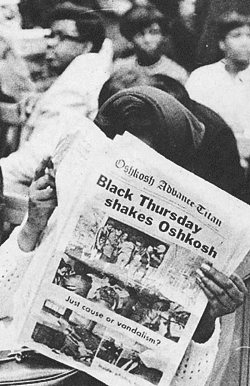
On November 21, 1968, ninety-four African American students attending Wisconsin State University at Oshkosh (WSU-O) engaged in a dramatic demonstration within the university president’s executive office. Citizens of Oshkosh and surrounding communities in Northeast Wisconsin—most of whom had only previously witnessed the civil rights movement and the turmoil of the 1960s through news broadcasts carried through their television sets—were stunned by the demonstration and the damage left in its wake. The public and official university reaction to the events of that day (soon dubbed “Black Thursday” by the student newspaper) was swift and punitive. Over the next several months, controversies surrounding the expulsion of the “Oshkosh 94” demonstrators, the conditions that triggered the demonstration, and the limits of academic freedom raged on, thus protracting the most significant crisis in race relations to ever hit the region.
This website draws from archival materials preserved at the University of Wisconsin Oshkosh Archives and the Wisconsin Historical Society, recently donated documents, newspaper and magazine articles, archived footage from Milwaukee news broadcasts, and over 130 oral history interviews. Taken together, the materials provided here gives students and teachers an opportunity to learn from Black Thursday’s historical legacy. As you consider these materials, you will hopefully learn something new about how issues of racial equality and justice were contested north of the Mason-Dixon line. Equally important, you will realize that the social and political divisions behind the “civil war” of the 1960s were so severe that even relatively quiet communities such as Oshkosh were not spared from them.



